|
%20of%20wildlifebar.JPG)
Yellowstone
National Park has the largest concentration of wildlife in the lower
48 states. The wildlife that visitors want to see the most in Yellowstone
are Bears, Wolves, Moose, Elk, Bison, Badgers, Otters, Fox and any
newborn critter.
The
following are the National Park Service Statistics for the wildlife
of Yellowstone:
-
61 Different mammals
-
Along
with black bears over 500 grizzlies live in the greater Yellowstone
ecosystem
-
Gray
wolves were restored in 1995; more than 370 live in the greater
Yellowstone ecosystem..
-
Wolverine
and Lynx live in the park and are some of the rarest mammals to
spot.
-
Seven
native species of ungulates—elk, mule deer, bison, moose, bighorn
sheep, pronghorn and white-tailed deer—live
here,
including one of the largest herds of elk in the United States.
-
Non-native
mountain goats have colonized the northwestern and northeastern
portions of the park.
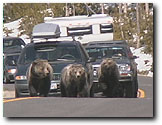 Bears Bears
Grizzly bears are perhaps the #1 sought after (from a distance) mammal
visitors would like to see. The best opportunity to see grizzlies are
early morning and late evening in Hayden and Lamar Valley. Grizzly bears
are identified by their large hump above the shoulders and their rump
is lower than the shoulders. They are larger than the black bear and
have a slightly upturned nose.
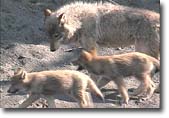 Wolves Wolves
There are currently 13 wolf packs making Yellowstone National Park their
home. The best areas to view wolves are Lamar and Hayden Valley during
the early morning and late evening hours. Look for Ravens scavaging
on a carcass. Wolves are some of the most intelligent mammals on the
planet. Treat them with the utmost respect. No wolf has attacked a human
in Yellowstone, but a few attacks have occurred in other places. Almost
all were from wolves that had become conditioned to human foods. Like
coyotes, wolves can quickly learn to associate campgrounds, picnic areas,
and roads with easy food. This often leads to aggressive behavior toward
humans. Even though the outdated distance rule of 25 yards applies to
wolves, give them at least 100 yards. Once Yellowstone wolves have become
habituated to humans and if fed they become a danger and must be relocated
or worse. You can identify a wolf from a coyote from its size. A wolf
can be 2 to 3 times larger than a coyote. A wolf has longer legs and
longer gallop. Their face is rounder, the ears and nose are not as sharp.
Most often than not they are with a pack whereas coyotes are often solitary.
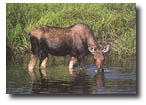 Moose Moose
There are over 400 Moose in Yellowstone, however their numbers have
declined in the last 40 years due to drought, predation, loss of habitat
and other factors. Moose are the largest member of the deer family and
can be found in the marshy areas of the park including lake shores and
along rivers. A bull moose in rut can be very dangerous so once again
the 25 yard rule should not apply to any large mammal during the rut.
Unlike elk, moose are solitary and can live up to 20 years in Yellowstone.
Their favorite food is willows and aquatic vegetation.
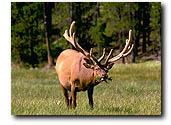 Elk Elk
Easily the largest population of large mammals in Yelllowstone Park
with over 15,000, elk in Yellowstone have a comfortable life. During
the fall, the bull elk in rut, is a favorite amongst wildlife watchers
and photographers. The mating season (rut) generally occurs from early
September to mid-October. Elk gather in mixed herds—lots of females
and calves, with a few bulls nearby. Bulls bugle to announce their availability
and fitness to females and to warn and challenge other bulls. When answered,
bulls move toward one another and sometimes engage in battle for access
to the cows. They crash their
antlers together, push each other intensely, and wrestle for dominance.
While loud and extremely strenuous, fights rarely cause serious injury.
The weaker bull ultimately gives up and wanders off. There is a great
sequence of this in the new dvd "Wildlife of Yellowstone".
Elk Calves are born in May and June and are some of the cutest newborns
in the park
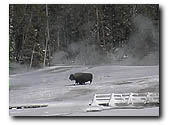 Bison Bison
Yellowstone National Park is the only place in the lower 48 states to
have a continuously free-ranging bison population since prehistoric
times. Because of their sheer physical size, their numbes increase each
year in Yellowstone Park. There are over 4,000 bison residing in Yellowstone
and are the #1 cause of summer jams in the park. Traffic can be at a
standstill for hours but still we love them. Bison mate in July and
August and the mature bulls begin their head butting during this mating
period. Bison can exceed over 2,000 lbs and cause more human injuries
than any other wildlife combined in Yellowstone Park. Given their docile
nature (except when in rut) visitors loose precaution when approaching
bison and that's when they become gore victims. Bison can exceed speeds
of 30 mph - how fast can the average Yellowstone tourist run. The smart
money would be on the Bison. Bison calves are born in late April and
May and again, due to the sheer size of their parents. rarely do the
calves become victims of predation. Like elk, bison are everywhere throughout
Yellowstone so there is no need to stop your vehicle in the middle of
the road the take a quick digital snapshot unless the bison are in the
road then please slowly give them the right of way.
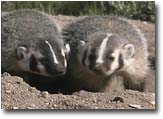 Badgers Badgers
Even though the park service lists the badger as common, most visitors
do not ever seen one when visiting Yellowstone. Badgers inhabit the
sageland or Savannah areas of the park like Lamar Valley. Badgers dig
for a living. They dig new dens and take over old ones prior to breeding.
They find their main food source, the ground squirrel or pocket gopher,
by digging. During the early and late hours of the day, when driving
along the sagebrush areas of the park, you may often locate a badger
by spotting a "dirt" geyser spouting out of the sagebrush.
This is your clue to a badger at work. Keep your distance, as they are
as ferocious as their elusive cousin the wolverine.
 Otters Otters
The Yellowstone otter is a favorite amongt wildlife watchers that come
to the park. These water mammals are very social and are always at play.
They inhabit the shorelines of lakes and river courses and can be found
along Yellowstone lake and river, Trout Lake and the Madison River.
Their main food source is the cutthroat trout, whitefish, clams and
anything else swimming in their enviironment. They use log jams and
river banks as their temporary shelter and often travel miles a day
in search of food and play.
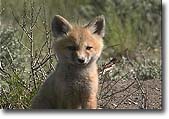 Fox Fox
The fox is the smallest of the dog family in Yellowtone Park. They are
a joy to watch but are highly elusive due to their cautious nature and
smaller size compared to their much large predatory cousin the wolf
and coyote. Unlike the wolf and coyote they rarely howl or sing. The
best time is early morning and late evening as they hunt the rodent
family that inhabit the park. The Yellowstone fox can be found primarily
in the northern section of the park like Specimen Ridge and Lamar Valley.
Foxes can become habituated to humans usually due to being fed. One
fox in the summer of 1997 was trapped and relocated three times from
the Tower Fall parking area because visitors fed it human food. The
fox was relocated between 10 and 60 miles away from Tower but twice
it returned. Finally the fox came to Mammoth where it was fed again
and as a result was destroyed.
Again
a fed animal is a dead animal - Good or Bad, the park service will destroy
animals that are habituated to human contact and food.
Yellowstone's
abundant and diverse wildlife are as famous as its geysers. Habitat
preferences and seasonal cycles of movement determine, in a general
sense, where a particular animal may be at a particular time. Early
morning and evening hours are when animals tend to be feeding and
thus are more easily seen. But remember that the numbers and variety
of animals you see are largely a matter of luck and coincidence. Check
at visitor centers for detailed information.
Wild animals, especially
females with young, are unpredictable. Keep a safe distance from all
wildlife. Each year a number of park visitors are injured by wildlife
when approaching too closely. Approaching on foot within 100 yards
(91 m) of bears or within 25 yards (23 m) of other wildlife is prohibited.
Please use roadside pullouts when viewing wildlife. Use binoculars
or telephoto lenses for safe viewing and to avoid disturbing them.
By being sensitive to its needs, you will see more of an animal's
natural behavior and activity. If you cause an animal to move,
you are too close!
Yellowstone also has a
wide variety of plant life. In the spring and early summer, wild flowers
appear in abundance. They are well worth viewing, and it is usually
safer to approach them.
All of Yellowstone is
bear country. Bears may appear tolerant of people but are known to
attack without warning. Feeding
wildlife is unlawful. Never leave food or garbage unattended. To decrease
the likelihood of personal injury, store all food and cooking utensils
in a secure place. Backcountry use may be restricted in some
areas to reduce human related impacts on bears in high density grizzly
bear habitat.
"The Essenstial DVDs
for Planning your
Trip to Yellowstone Park" |
|
|
|
|
Bear Encounters
Yellowstone is home to both
grizzly and black bears. Although the risk of an encounter with a bear
is low, there are no guarantees of your safety. Minimize your risks
by following the guidelines below:
Make bears aware of your
presence on trails by making loud noises such as shouting or singing.
This lessens the chance of sudden encounters, which are the cause of
most bear-caused human injuries in the park. Hike in groups and use
caution where vision is obstructed.
- Do not hike after dark.
- Avoid carcasses; bears often defend
this source of food.
If you encounter a bear,
do not run. Bears can run over 30 miles per hour, or 44 feet per second,
faster than Olympic sprinters. Running may elicit an attack from otherwise
non-aggressive bears. If the bear is unaware of you, detour away from
the bear. If the bear is aware of you and nearby, but has not acted
aggressively, slowly back away.
Tree climbing to avoid bears
is popular advice but not very practical in many circumstances. All
black bears, all grizzly cubs, and some adult grizzlies can climb trees.
Running to a tree may provoke an otherwise uncertain bear to chase you.
Some bears will bluff their
way out of a threatening situation by charging, then veering off or
stopping abruptly at the last second. Bear experts generally recommend
standing still until the bear stops and then slowly backing away. If
you are attacked, play dead. Drop to the ground, lift your legs up to
your chest, and clasp your hands over the back of your neck. This technique
has been especially successful with female bears that have cubs.
- National Park
Service
|

